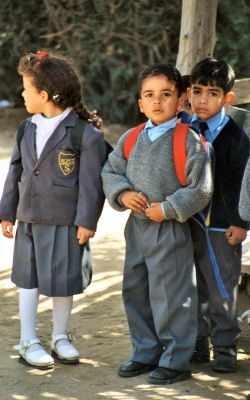Village Background from Alexandria, Egypt
 SOS Children's Village Alexandria
SOS Children's Village Alexandria
Alexandria is Egypt's most important Mediterranean harbour and is located on the western fringe of the Nile Delta. With a population of more than 4 million people, it is the second largest city in Egypt after Cairo. The people in both cities who have come from rural areas and are living in poverty have grown in numbers in the last few years, and the resulting population growth rate is double that of other cities in Egypt. The job markets have not been large enough to offer work to all the new-comers, and the available living quarters have also been insufficient. The financial and social situation of those coming from rural areas has become increasingly difficult and precarious, and the number of orphaned and abandoned children has continued to increase. These conditions were what moved SOS Children’s Villages to build the first two villages in those cities.
The SOS Children's Village Alexandria was built on a beautiful green terrain, 33 km outside the city, on the road leading to Cairo. It comprises 11 family houses in which up to 100 children can be cared for, a house for the Village Director, accommodation for SOS aunts (SOS aunts take care of the children when SOS mothers are on leave), an administrative and a service block, and various adjacent buildings housing a laundry facility, a workshop, and a clinic.
Other SOS Projects in Alexandria
The SOS Nursery which is part of the SOS Children’s Village is also attended by children from the neighbouring community. It comprises five classes in which 110 children are cared for, an outdoor playground and an administration room. In 1987, the SOS Primary School was opened, and it is presently providing approximately 425 students with an education. It is run as a private school open to the public, and school fees must be paid. The school consists of ten classrooms, three laboratories and an administration room. In order to help teenagers become independent, six SOS Youth Homes for boys were built in Alexandria. The girls are accommodated in a Youth Home within the precincts of the SOS Children’s Village since in Egypt unmarried girls cannot live on their own, for traditional and social reasons. As soon as youths reach the age of about 14, they move to one of the three SOS Youth Homes, where they are taken care of by a youth leader. Being admitted to an SOS Youth Home means taking responsibility for themselves and is synonymous to making a big step towards independence. Being fully aware of this, SOS mothers, the Village Director and a psychologist prepare them carefully for that change. Usually, youths stay up to four years in an SOS Youth Home. They may stay longer, however, if they are looking for work, completing professional training or studying at a university.
The SOS Children's Village in Alexandria includes several bungalows so that children from other SOS Children's Villages in Egypt can enjoy the beautiful beach on which the village is located. Every year, a summer camp takes place there, and this is an exciting event for all.
Background to Alexandria
With a population of 4.1 million, Alexandria is the second-largest city in Egypt, and is the country's largest seaport, serving approximately 80% of Egypt's imports and exports. Alexandria extends about 32 km (20 mi) along the coast of the Mediterranean Sea in north-central Egypt. It is an important industrial centre because of its natural gas and oil pipelines from Suez, another city in Egypt.
In ancient times, Alexandria was one of the most famous cities in the world. It was founded around a small pharaonic town c. 331 BC by Alexander the Great. It remained Egypt's capital for nearly a thousand years, until the Muslim conquest of Egypt in AD 641 when a new capital was founded at Fustat (Fustat was later absorbed into Cairo). Alexandria was known because of its lighthouse (Pharos), one of the Seven Wonders of the Ancient World; its library (the largest library in the ancient world); and the Catacombs of Kom el Shoqafa, one of the Seven Wonders of the Middle Ages. Ongoing maritime archaeology in the harbour of Alexandria, which began in 1994, is revealing details of Alexandria both before the arrival of Alexander, when a city named Rhacotis existed there, and during the Ptolemaic dynasty.
From the late 19th century, it became a major centre of the international shipping industry and one of the most important trading centres in the world, both because it profited from the easy overland connection between the Mediterranean Sea and the Red Sea, and the lucrative trade in Egyptian cotton.

 Return to Schools Wikipedia Home page…
Return to Schools Wikipedia Home page…
